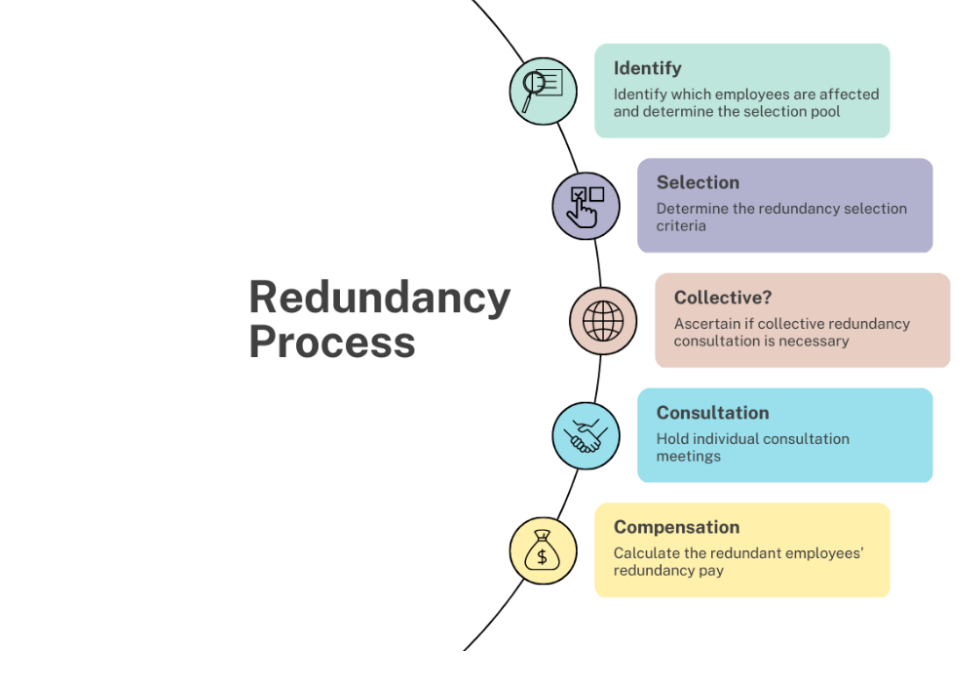A redundancy process, while not entered into lightly is sometimes necessary in order to sustain a business in the long-term and protect roles. Redundancy has increasingly been in the news, with high-profile examples in the technology sector, and last year with P&O Ferries controversial redundancy of 800 workers. However, not all redundancy processes are created equal.
In this article, and in our upcoming webinar, we provide a summary of key practical considerations for employers planning for redundancies, ways to address the potential negative impacts of the process and discuss how leaders can best navigate this challenging period.
Impacts
Redundancies can be a very stressful experience for those involved and employers have a duty to follow a fair process. Redundancy can impact a business negatively in several ways, such as:
- Increased risk of unfair dismissal claims
- Reputational damage among customers, clients, current employees and potential future employees
- Loss of business knowledge of employees made redundant
- Psychological repercussions among remaining staff, e.g., higher turnover or lower productivity
- Short-term financial loss (compensation pay-outs)
Practicalities of the Redundancy Process
Employers will need to demonstrate that they have reasonably considered alternatives to compulsory redundancy. This might include for example, pausing recruitment, considering temporary lay-off or short-time working, or seeking volunteers.
Where compulsory redundancy cannot be avoided, employers should begin planning the process of identifying, selecting and terminating the employment of those individuals whose roles are at risk of redundancy. The planning process includes a number of key steps, such as:
- Identification of the correct ‘pool’ of employees who will be placed at risk of redundancy – “the pool”. – The business rationale for this should be clearly documented and careful consideration should be given to any affected employees who are pregnant or on maternity leave.
- Conducting timely and meaningful consultation – Employers are legally obliged to consult employee representatives where they are proposing to make 20 or more employees redundant within a 90 day period. The consultation process should begin at least 30 days before the first dismissal take effect if 20 to 99 employees are to be made redundant and 45 days before the first dismissal take effect if 100 employees or more are being made redundant. Employers are also obliged to conduct meaningful consultation with employees where less than 20 employees are at risk of redundancy, though there are no specific timescales over which that should occur. The purpose of such consultation is to discuss and agree with employees how the redundancy process will be carried out.
- Establishment of selection criteria used to assess employees in the pool – These should be both measurable and objective and may include skills, competencies and qualifications. Employers should be mindful of the potential discriminatory impact of any criteria and how any impact could be eliminated, e.g. if absence levels are considered without any adjustments this could have a discriminatory impact on pregnant females or disabled employees who may have had sickness absence relating to their pregnancy or disability.
- Ensure that meetings are carried out with those employees who are selected – Allow them to respond and appeal against any decision to terminate their employment on the grounds of redundancy. In redundancy situations where less than 20 employees are to be made redundant this includes ensuring that the 3 step Statutory Dismissal Procedure is followed.
- Ensure that employees are informed about and paid Statutory Redundancy payments – These are calculated according to a formula based on age, length of service and an individual’s weekly pay. Employers may also opt to pay an enhanced redundancy payment but are not under any legal obligation to do so.

Diagram summarising the key considerations in a redundancy process.
Upcoming Webinar: Redundancy Planning for Managers
Even the most well-planned redundancy processes may encounter obstacles and challenges. We would encourage employers to engage the support of HR experts to help manage the process smoothly and reduce the risk of potential liability to your organisation.
Think People Consultants have a wealth of experience in planning and managing redundancy processes. Attend our webinar on Wednesday 15th March 2023 at 10am. Click here to register, we still have some spaces remaining.
We can also offer bespoke advice on all aspects of workforce planning. For more information, please contact us at enquiries@thinkpeople.co.uk or by calling 02890 310450 (ROI – 00353 1969 7865).
